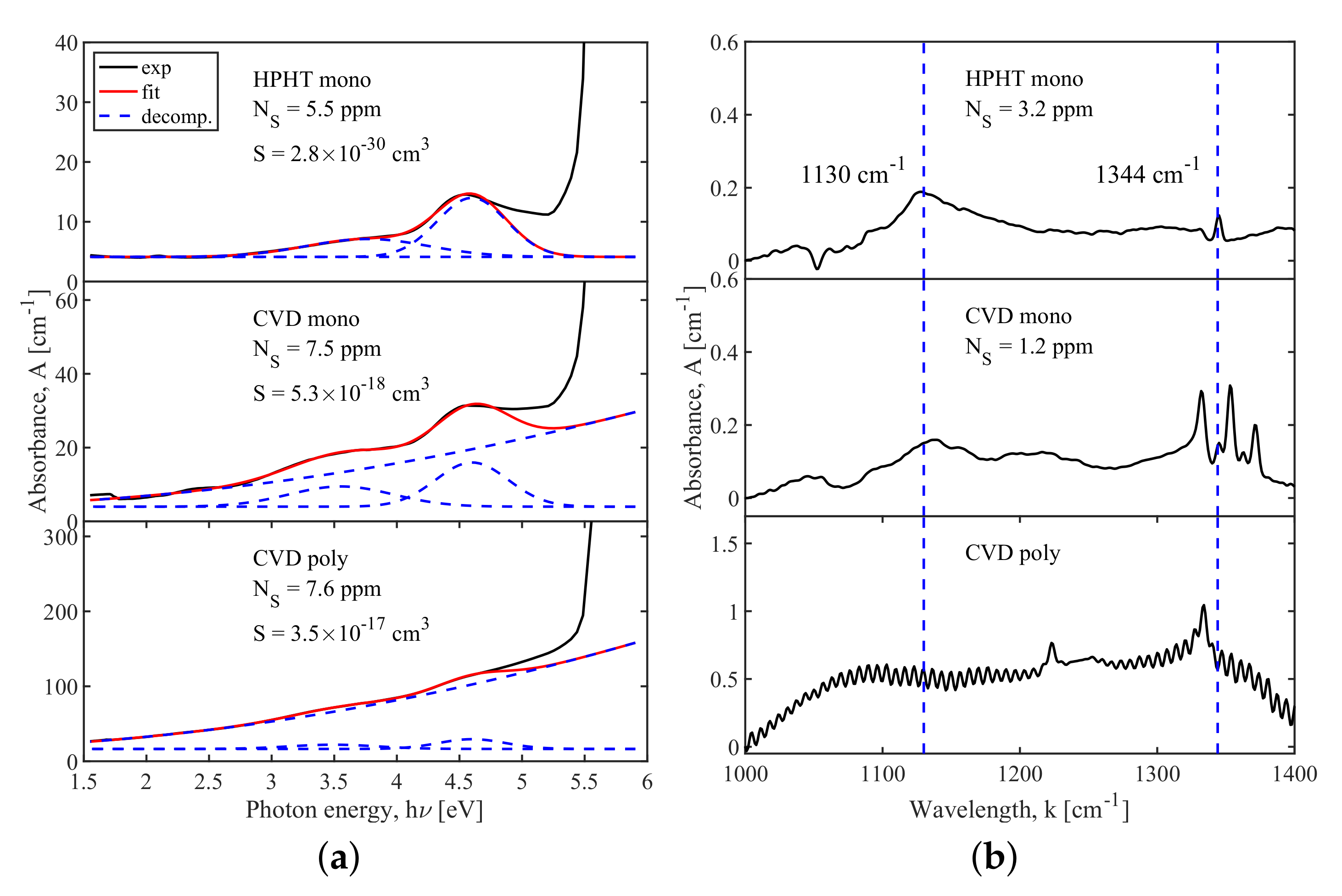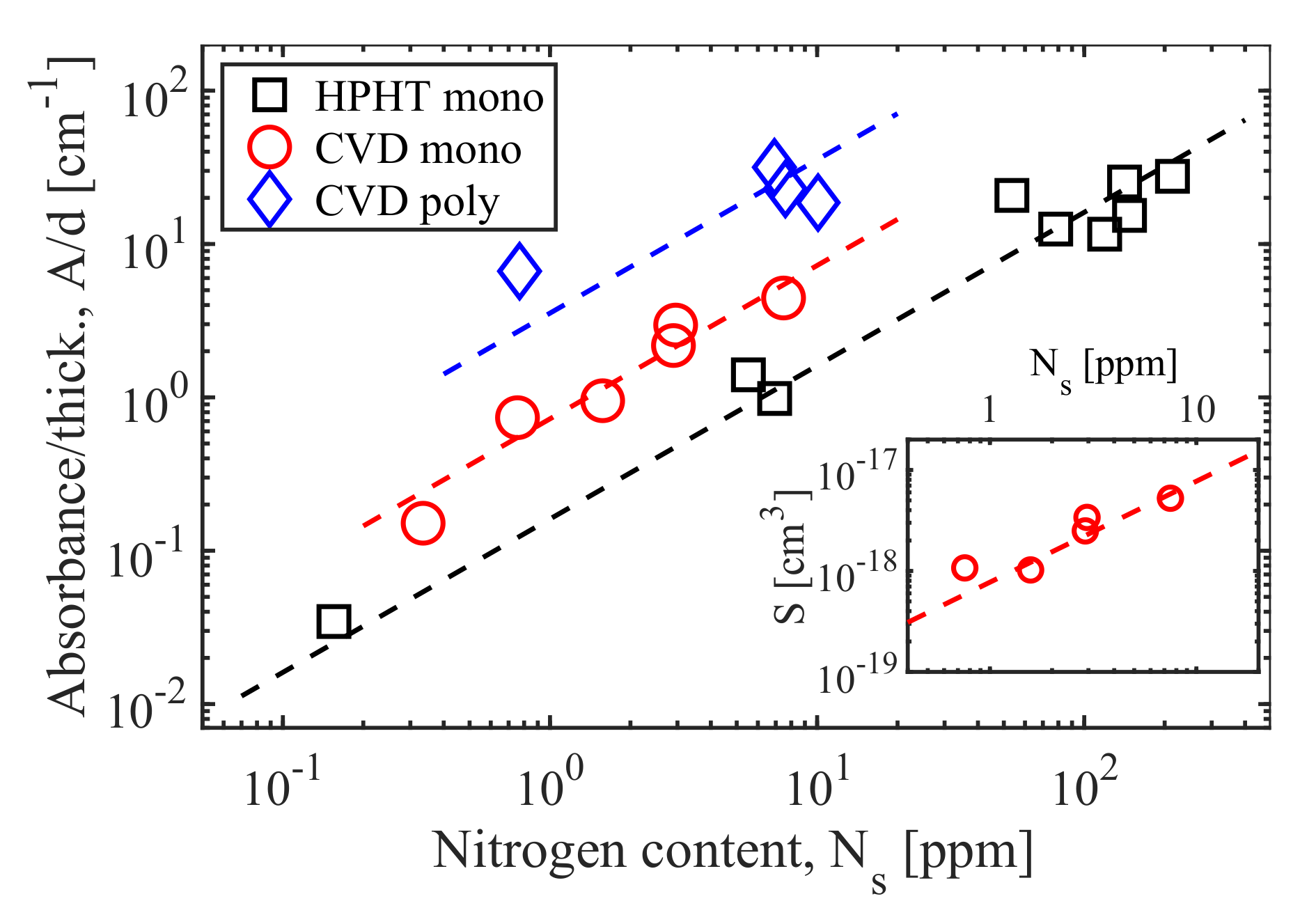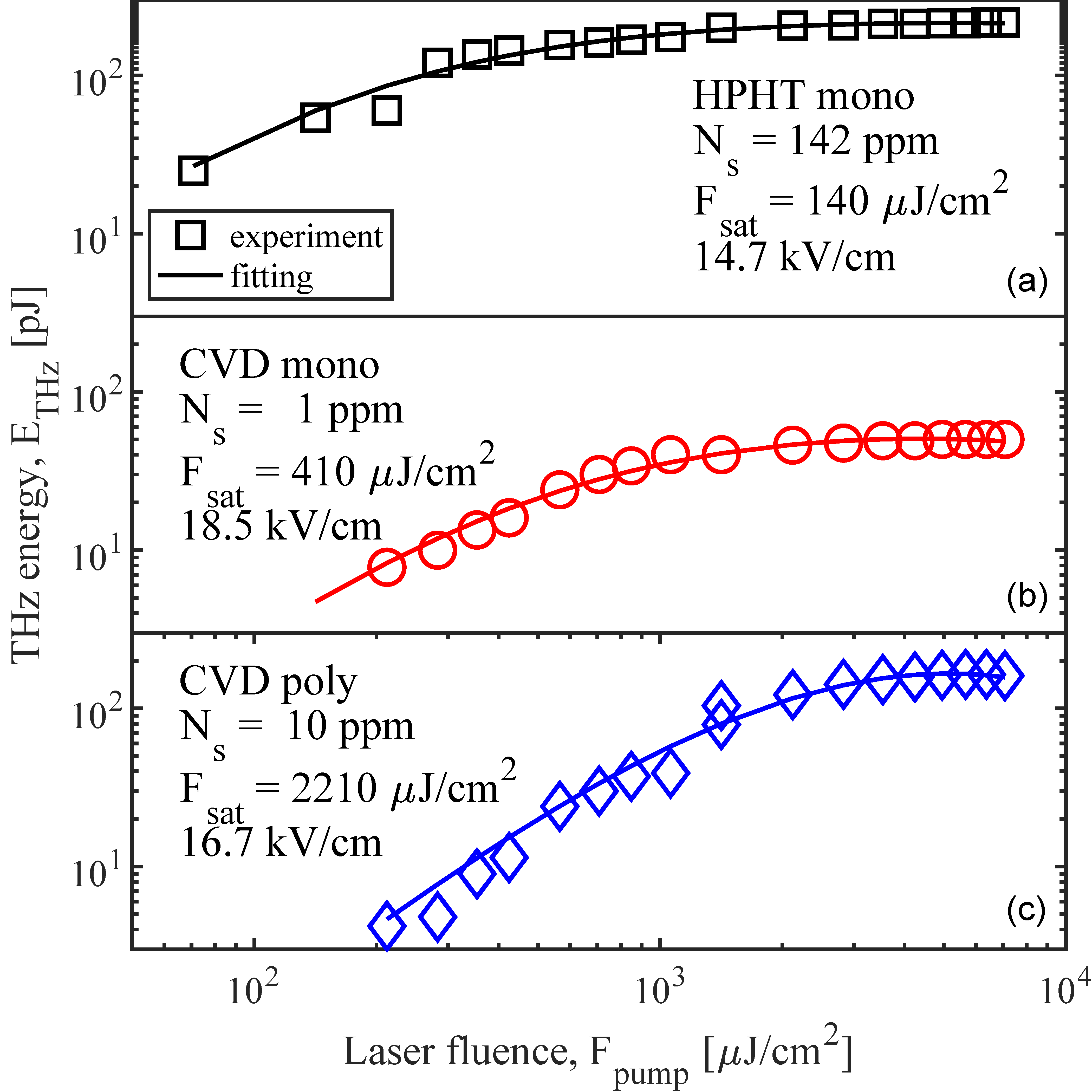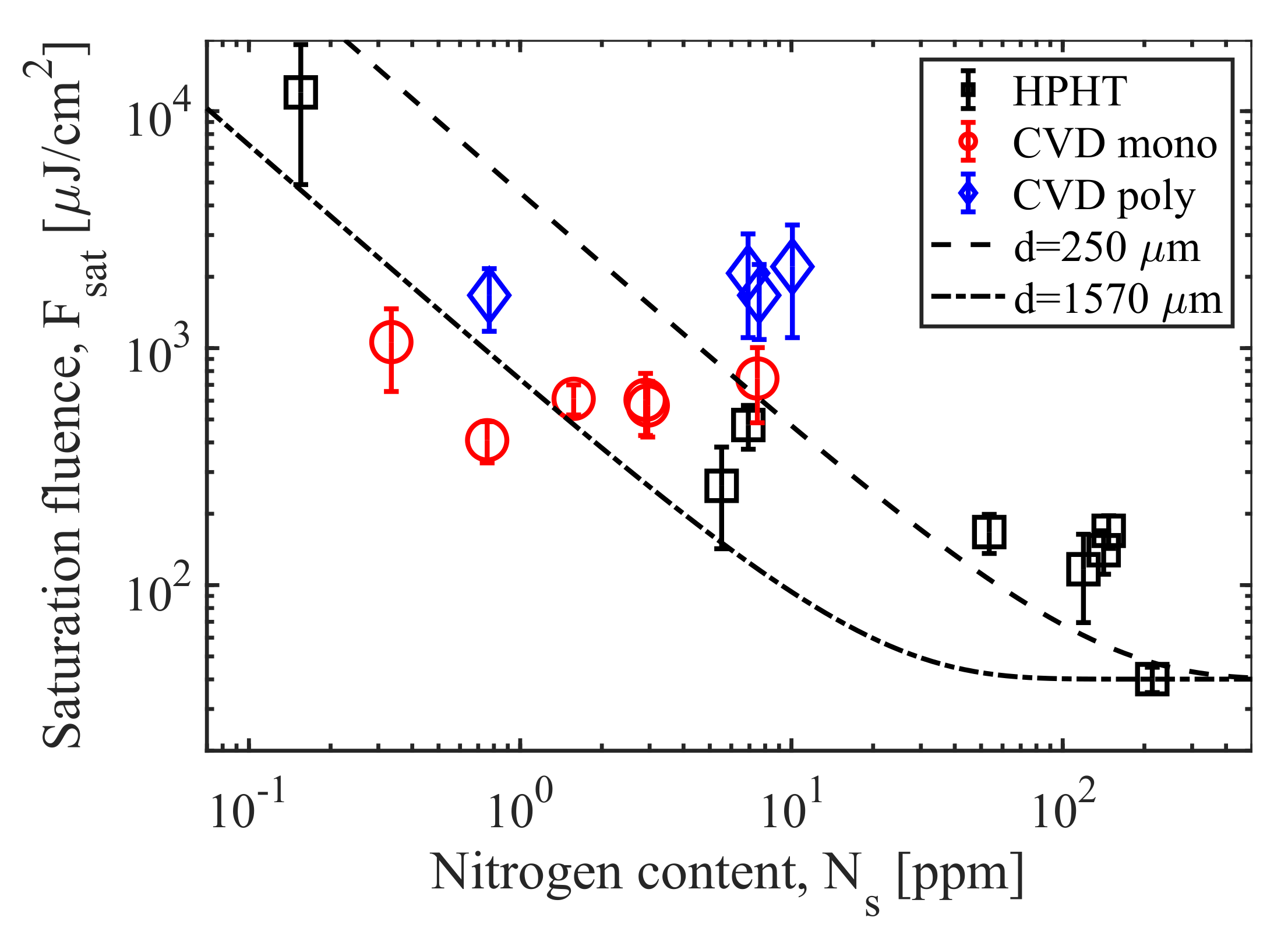Efficiency of Photoconductive Terahertz Generation in Nitrogen-Doped Diamonds
Abstract
:1. Introduction
2. Materials and Methods
3. Results and Discussion
3.1. Optical Properties of Nitrogen-Doped Monocrystalline HPHT and Monocrystalline and Polycrystalline CVD Diamonds
3.2. Photoconductive THz Antennas Based on Nitrogen-Doped Monocrystalline HPHT and Monocrystalline and Polycrystalline CVD Diamonds
4. Conclusions
Author Contributions
Funding
Institutional Review Board Statement
Informed Consent Statement
Data Availability Statement
Conflicts of Interest
Abbreviations
| PCA | photoconductive antenna |
| HPHT | high pressure - high temperature |
| CVD | chemical vapor deposition |
| PTFE | polytetrafluoroethylene |
| BBO | -barium borate |
References
- Lee, C.H. Picosecond optoelectronic switching in GaAs. Appl. Phys. Lett. 1977, 30, 84–86. [Google Scholar] [CrossRef]
- Yang, K.; Richards, P.; Shen, Y. Generation of far-infrared radiation by picosecond light pulses in LiNbO3. Appl. Phys. Lett. 1971, 19, 320–323. [Google Scholar] [CrossRef] [Green Version]
- Oh, T.; Yoo, Y.; You, Y.; Kim, K. Generation of strong terahertz fields exceeding 8 MV/cm at 1 kHz and real-time beam profiling. Appl. Phys. Lett. 2014, 105, 041103. [Google Scholar] [CrossRef]
- Fattinger, C.; Grischkowsky, D. Terahertz beams. Appl. Phys. Lett. 1989, 54, 490–492. [Google Scholar] [CrossRef]
- Burford, N.M.; El-Shenawee, M.O. Review of terahertz photoconductive antenna technology. Opt. Eng. 2017, 56, 010901. [Google Scholar] [CrossRef]
- Hafez, H.; Chai, X.; Ibrahim, A.; Mondal, S.; Férachou, D.; Ropagnol, X.; Ozaki, T. Intense terahertz radiation and their applications. J. Opt. 2016, 18, 093004. [Google Scholar] [CrossRef]
- Chai, X.; Ropagnol, X.; Ovchinnikov, A.; Chefonov, O.; Ushakov, A.; Garcia-Rosas, C.; Isgandarov, E.; Agranat, M.; Ozaki, T.; Savel’ev, A. Observation of crossover from intraband to interband nonlinear terahertz optics. Opt. Lett. 2018, 43, 5463–5466. [Google Scholar] [CrossRef] [PubMed]
- Yoneda, H.; Tokuyama, K.; Ueda, K.; Yamamoto, H.; Baba, K. High-power terahertz radiation emitter with a diamond photoconductive switch array. Appl. Opt. 2001, 40, 6733–6736. [Google Scholar] [CrossRef]
- Imafuji, O.; Singh, B.P.; Hirose, Y.; Fukushima, Y.; Takigawa, S. High power subterahertz electromagnetic wave radiation from GaN photoconductive switch. Appl. Phys. Lett. 2007, 91, 071112. [Google Scholar] [CrossRef]
- Ropagnol, X.; Morandotti, R.; Ozaki, T.; Reid, M. Toward high-power terahertz emitters using large aperture ZnSe photoconductive antennas. IEEE Photonics J. 2011, 3, 174–186. [Google Scholar] [CrossRef]
- Ropagnol, X.; Bouvier, M.; Reid, M.; Ozaki, T. Improvement in thermal barriers to intense terahertz generation from photoconductive antennas. J. Appl. Phys. 2014, 116, 043107. [Google Scholar] [CrossRef]
- Ropagnol, X.; Kovács, Z.; Gilicze, B.; Zhuldybina, M.; Blanchard, F.; Garcia-Rosas, C.; Szatmári, S.; Földes, I.; Ozaki, T. Intense sub-terahertz radiation from wide-bandgap semiconductor based large-aperture photoconductive antennas pumped by UV lasers. New J. Phys. 2019, 21, 113042. [Google Scholar] [CrossRef] [Green Version]
- Bulgakova, V.; Ushakov, A.A.; Chizhov, P.A.; Yudin, N.; Zinovev, M.; Podzyvalov, S.; Dolmatov, T.; Bukin, V.; Garnov, S. Terahertz generation by means of ZnGeP2 large aperture photoconductive antenna. Opt. Eng. 2021, 60, 082015. [Google Scholar] [CrossRef]
- Yoneda, H.; Ueda, K.I.; Aikawa, Y.; Baba, K.; Shohata, N. Photoconductive properties of chemical vapor deposited diamond switch under high electric field strength. Appl. Phys. Lett. 1995, 66, 460–462. [Google Scholar] [CrossRef]
- Kubarev, V. Optical properties of CVD-diamond in terahertz and infrared ranges. Nucl. Instrum. Methods Phys. Res. Sect. A Accel. Spectrom. Detect. Assoc. Equip. 2009, 603, 22–24. [Google Scholar] [CrossRef]
- Komlenok, M.; Kononenko, T.; Sovyk, D.; Pavelyev, V.; Knyazev, B.; Ashkinazi, E.; Reshetnikov, A.; Komandin, G.; Pashinin, V.; Ralchenko, V.; et al. Diamond diffractive lens with a continuous profile for powerful terahertz radiation. Opt. Lett. 2021, 46, 340–343. [Google Scholar] [CrossRef]
- Isberg, J.; Hammersberg, J.; Johansson, E.; Wikström, T.; Twitchen, D.J.; Whitehead, A.J.; Coe, S.E.; Scarsbrook, G.A. High carrier mobility in single-crystal plasma-deposited diamond. Science 2002, 297, 1670–1672. [Google Scholar] [CrossRef] [PubMed]
- Chizhov, P.A.; Komlenok, M.S.; Kononenko, V.V.; Bukin, V.V.; Ushakov, A.A.; Bulgakova, V.V.; Khomich, A.A.; Bolshakov, A.P.; Konov, V.I.; Garnov, S.V. Photoconductive terahertz generation in nitrogen-doped single-crystal diamond. Opt. Lett. 2022, 47, 86–89. [Google Scholar] [CrossRef]
- Iakoubovskii, K.; Adriaenssens, G. Optical transitions at the substitutional nitrogen centre in diamond. J. Phys. Condens. Matter 2000, 12, L77. [Google Scholar] [CrossRef]
- Nistor, S.V.; Stefan, M.; Ralchenko, V.; Khomich, A.; Schoemaker, D. Nitrogen and hydrogen in thick diamond films grown by microwave plasma enhanced chemical vapor deposition at variable H2 flow rates. J. Appl. Phys. 2000, 87, 8741–8746. [Google Scholar] [CrossRef]
- Benicewicz, P.; Roberts, J.; Taylor, A. Scaling of terahertz radiation from large-aperture biased photoconductors. JOSA B 1994, 11, 2533–2546. [Google Scholar] [CrossRef]
- You, D.; Jones, R.; Bucksbaum, P.; Dykaar, D. Generation of high-power sub-single-cycle 500-fs electromagnetic pulses. Opt. Lett. 1993, 18, 290–292. [Google Scholar] [CrossRef] [PubMed] [Green Version]






Publisher’s Note: MDPI stays neutral with regard to jurisdictional claims in published maps and institutional affiliations. |
© 2021 by the authors. Licensee MDPI, Basel, Switzerland. This article is an open access article distributed under the terms and conditions of the Creative Commons Attribution (CC BY) license (https://creativecommons.org/licenses/by/4.0/).
Share and Cite
Kononenko, V.V.; Komlenok, M.S.; Chizhov, P.A.; Bukin, V.V.; Bulgakova, V.V.; Khomich, A.A.; Bolshakov, A.P.; Konov, V.I.; Garnov, S.V. Efficiency of Photoconductive Terahertz Generation in Nitrogen-Doped Diamonds. Photonics 2022, 9, 18. https://doi.org/10.3390/photonics9010018
Kononenko VV, Komlenok MS, Chizhov PA, Bukin VV, Bulgakova VV, Khomich AA, Bolshakov AP, Konov VI, Garnov SV. Efficiency of Photoconductive Terahertz Generation in Nitrogen-Doped Diamonds. Photonics. 2022; 9(1):18. https://doi.org/10.3390/photonics9010018
Chicago/Turabian StyleKononenko, Vitali V., Maxim S. Komlenok, Pavel A. Chizhov, Vladimir V. Bukin, Vladislava V. Bulgakova, Andrey A. Khomich, Andrey P. Bolshakov, Vitaly I. Konov, and Sergey V. Garnov. 2022. "Efficiency of Photoconductive Terahertz Generation in Nitrogen-Doped Diamonds" Photonics 9, no. 1: 18. https://doi.org/10.3390/photonics9010018
APA StyleKononenko, V. V., Komlenok, M. S., Chizhov, P. A., Bukin, V. V., Bulgakova, V. V., Khomich, A. A., Bolshakov, A. P., Konov, V. I., & Garnov, S. V. (2022). Efficiency of Photoconductive Terahertz Generation in Nitrogen-Doped Diamonds. Photonics, 9(1), 18. https://doi.org/10.3390/photonics9010018




